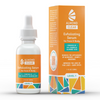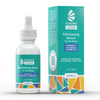Scalp Folliculitis Treatment
Scalp Folliculitis Signs and Symptoms
Scalp folliculitis is a frustrating, sometimes painful skin condition that happens when the hair follicle gets infected. It typically looks like clusters of red bumps that can have whiteheads or closed papules (like small cysts). The bumps can feel tender, and if they’re caused by a fungal skin infection then they may itch.
Scalp Folliculitis Causes
Scalp folliculitis is most often caused by a buildup of gunk on the scalp. Your scalp is full of hair follicles and oil glands, and if the follicle or pore becomes clogged with dirt, sweat, oil, or hair care products, a breakout is likely to occur. Here are some other common causes of scalp blemishes:
- Fungal or bacterial skin infections can cause scalp blemishes. The good news is that the same product can clear both fungal and bacterial skin imbalances (more on that later).
- A buildup of dead skin cells on the surface of the scalp can obstruct the hair follicles and cause folliculitis. Some people tend to produce new skin cells at a rapid rate, causing dead skin cells to flake off quickly. These flakes can build up and plug hair follicles.
- Hair products like shampoo, hair gel, or hairspray can sit on top of the scalp and clog your skin.
- If you have coarse, curly hair then you’re more likely to get scalp folliculitis. This is because curly hair is more likely to get ingrown after shaving or close cutting.
- Scalp folliculitis can be caused by living in a warm, humid environment because the breakout-causing microbes reproduce best in warm and moist conditions.
- Excessive sweating can aggravate your scalp acne or folliculitis. When sweat mixes with your body’s natural oil, it creates the perfect feast for folliculitis-causing microbes.
- If you have an underlying health condition that weakens the immune system, you may be at a higher risk of scalp folliculitis.

Different Types of Scalp Folliculitis
There are a few different types of scalp folliculitis, so it’s important to know which type you have and how to treat it properly. Here are the most common types of scalp folliculitis:
- Bacterial folliculitis: Occurs when the hair follicles become infected with bacteria, usually Staphylococcus aureus (staph). This staph bacteria enters the body through a cut or another wound causing a rash of itchy, pus-filled bumps.
- Fungal folliculitis: Your skin can experience fungal overgrowth, and the fungus infects and clogs hair follicles. This type of folliculitis is often itchy. To fight this type of folliculitis, you’ll need to be careful about which hair products you use because many products can make the problem worse. Check out the Folliculitis Scout website for more information.
- Razor bumps (pseudofolliculitis barbae): This rash is actually caused by ingrown hairs. It mainly affects people with very curly hair who shave too close to the skin. Cutting the hair farther from the skin can prevent the problem from recurring.
- Gram-negative folliculitis: This occurs after long-term use of antibiotics because antibiotics disrupt the normal bacterial balance of the skin, leading to large, pus-filled pimples that sit in the deep layers of the skin.
- Dissecting cellulitis of the scalp (DCS): This is a chronic inflammatory disorder of the scalp that causes deep, large nodules, often associated with patchy hair loss. DCS tends to be pretty severe and is best treated by a dermatologist who can determine the best plan for you.
Scalp Folliculitis Treatment
To clear up scalp folliculitis, you have several good options.
- Apply a Mandelic Acid serum: Mandelic acid is an alpha hydroxy acid that's derived from bitter almonds. It is naturally antibacterial, antifungal and exfoliating so it unclogs blocked hair follicles, and stops the microbes that cause both bacterial and fungal folliculitis to grow. For information about how MA clears scalp blemishes, see below.
- Shampoo with ketoconazole: Ketoconazole is an anti-fungal ingredient that’s primarily used to treat dandruff, but washing fungal acne-prone skin with this stuff works wonders for fighting off fungus. This is because it’s great at sloughing off dead skin cells, and it even has strong antimicrobial properties. Try washing your hair with a Ketoconazole-containing shampoo like Nizoral.
- Get a prescription for a topical antibacterial or antifungal cream: If a doctor or dermatologist diagnoses you with fungal acne, they may write you a prescription for antifungals that are either oral (taken by mouth) or topical (applied to the skin). There’s a bunch of different antifungal prescriptions to choose from, and your doctor will know which one is right for you. Please note that Antifungal medications are best taken for shorter periods of time because they can throw off your body’s microbiome, causing more skin issues down the line. After your skin clears up, you can stop taking the prescription antifungal and continue keeping the fungal acne at bay by regularly applying a mandelic acid serum.
- Temporarily stop buzzing or shaving your head: Shaving and buzzing create finer hairs with a sharper edge, and these wispy hairs are more likely to grow sideways or poke back under the skin and get trapped, causing folliculitis bumps. It’s best to temporarily stop buzzing or shaving your head for a few weeks to allow those hairs to grow so that they’re not trapped underneath the skin.

Scalp Folliculitis Treatment with Mandelic Acid
Mandelic Acid serums can be very effective at banishing and preventing scalp folliculitis. Here’s how Mandelic Acid works to clear your skin:
- MA has naturally occurring antibacterial and antifungal properties that allow it to clear the bacteria and microbes that cause acne and folliculitis to occur.
- MA unclogs blocked hair follicles and pores by exfoliating dead skin cells and oil.
- MA reduces redness and inflammation so that blemishes start looking calmer and less red.
- MA is the gentlest skincare acid, so causes less dryness and irritation than other skincare acids.
Types of Scalp Folliculitis That Can Be Cleared With Mandelic Acid
- Bacterial folliculitis
- Fungal folliculitis
- Razor bumps (pseudofolliculitis barbae)
- Gram-negative folliculitis
Types of Scalp Folliculitis That Need a Dermatologist or Other Treatment
- Dissecting cellulitis of the scalp (DCS): if you’re experiencing DCS then it’s recommended that you get treated by a dermatologist.
- You should see a doctor if you have large, painful cysts on your scalp that leave scars. It is especially important to see a doctor if you are experiencing raised scars (called keliod scars) because this type of scaring can be permanent. A dermatologist can help to reduce large cysts and scaring.

Lifestyle Changes That Can Improve Scalp Folliculitis
- After exercising or sweating, wash your scalp as soon as possible. Folliculitis loves warm, moist conditions, and the combination of sweat and oil contain all of the nutrients needed for the reproduction of folliculitis-causing microbes. It’s very important to shower right after sweating. If you can’t shower after exercising, then it’s helpful to apply a little Almond Clear to your scalp. This will keep the microbes from spreading until you can shower up.
- Wash the scalp regularly with antimicrobial shampoo such as ketoconazole.
- Be sure to clean your hair styling products as often as possible.
- Avoid wearing tight hats or helmets for long periods of time.
- Avoid shaving the head with a dull or unclean razor. If you’re a Black man or a person with very curly hair, then shave with a single blade razor. Bevel razors are a good option.
- Avoid unclean hot tubs and pools.
- Take an oral antifungal supplement. Good choices include caprylic acid, undecylenic acid, oil of oregano, garlic, olive leaf, and berberine. *make sure to consult your doctor before taking new any new supplement.
- Avoid prolonged exposure to hot or warm water. This means minimizing your time in hot tubs, baths, and steam rooms. You don’t have to eliminate steamy water from your life, just avoid it when you can.
Blemishes on the scalp can be frustrating and painful, but by following these tips, you should be able to clear up your skin. If you’re still experiencing folliculitis breakouts even after following these steps then consider visiting a dermatologist or aesthetician who specializes in acne and folliculitis so that they can evaluate your skin.








